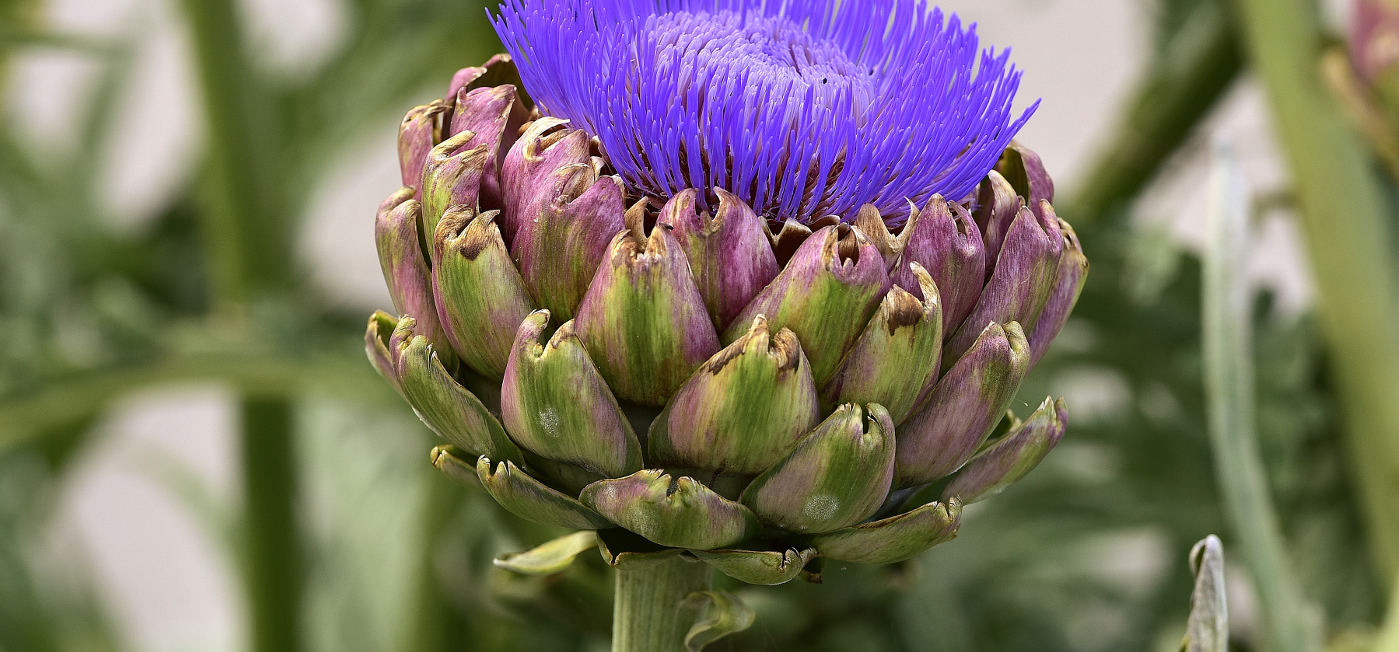Artichoke
The artichoke is a flavoursome vegetable and also a superb ornamental garden plant thanks to its lovely purple flowers. It is eaten raw or cooked depending on the variety, hot or cold, alone or as a side dish.
Mediterranean origins
Originating in the Mediterranean basin, artichokes were probably first cultivated in Andalusia or Tunisia. They undoubtedly reappeared in Italy during the Renaissance (mid-15th century), and had pride of place on all the finest tables in Europe. The Spanish and French colonists developed its cultivation in America, in California and Louisiana respectively.
A tasty surprise
Although they are spread across the five continents, the biggest artichoke producers are still concentrated in the Mediterranean basin. Italy, Spain and Egypt alone produce more than half of the 1600 tonnes harvested around the world every year. Artichoke cultivation takes up a large amount of space. Artichoke heads are still harvested by hand and, since this depends on their ripening, this may span several weeks. This leads to particularly high production costs, making artichokes among the most expensive vegetables on the market (at equivalent edible quantities). They are harvested in Europe from June to November and in California from March to May.
Artichoke heads are eaten raw or cooked. However, care must be taken to remove the choke (for the largest specimens) and the outermost ‘leaves’ or bracts, which are too tough and rather bitter. The small, purple poivrade artichoke is eaten whole, or peeled and cooked for a short time. Some Italian varieties of purple artichokes are especially eaten raw, thinly sliced, with salt, lemon juice and olive oil. Artichokes can be boiled in salted water, steamed, microwaved, roasted or braised, etc. They are eaten hot, warm or cold, alone or accompanied by vinaigrette or mayonnaise, for example. The heart, frequently preserved or marinated, can be added to salads and appetisers or used as a garnish. The real leaves, the ones that grow along the stem, can also be eaten blanched or cooked.
Artichokes have a surprise in store! If you drink pure water after having eaten an artichoke, the water will taste sweet. This curious effect is explained by the presence of cynarine in artichokes. Cynarine is a compound that inhibits the sweet flavour receptors on the tongue. Once the cynarine is rinsed away with water, the receptors are disinhibited and their reactivation creates a contrast that makes it seem like the water has sugar in it.
A thistle with a tender heart
The artichoke (Cynara scolymus) is a hardy plant from the Asteraceae family. Just like its cousin, the cardoon (Cynara cardunculus), the artichoke was originally a wild thistle which became the plant we know today through cross-breeding and improvements in cultivation. This plant has a thick, ribbed stem that can grow to a height of 2 m, with large leaves of varying sizes, and a head.
When the artichoke is allowed to develop, it forms a magnificent flower at the top which varies in colour from blue to purple. In fact it is a cluster of flowers, each one of them taking the form of a tuft of hair called a pappus, with a minuscule ovary (future fruit) at its base. It is this group of unopened flowers that forms the edible choke of artichokes. What we generally call the centre or heart of the artichoke is in fact the fleshy receptacle of the flowers. We eat the base of what we refer to as the ‘leaves’, but which are actually bracts or scales, a kind of sepal that protects the flowers.
The many varieties of artichoke are divided into two main categories: artichokes with a round flower bud (such as Camus de Bretagne weighing around 500 g each, Gros Vert de Laon, Spanish Calico etc.) and conical ones that are often smaller (poivrades, bouquets, Violet de Provence, etc.).
A dietary aide
Known for its digestive properties for centuries, the artichoke is a good source of vitamin B3, magnesium, phosphorus, potassium and copper, as well as fibre (including inulin) and antioxidants (vitamin C and polyphenols). It is among the food with the highest levels of chlorogenic acid, a polyphenol whose antioxidant power is thought to help combat the formation of atheroma plaques. Inulin is a group of dietary fibres capable of having a positive influence on gastrointestinal function by promoting the development of bifido-bacteria in the colon.
An alternative way of making cheese
Did you know that artichoke flowers can be used in the cheese-making process? They contain enzymes called cynarases which have milk-clotting properties. These properties have been put to good use for many centuries in the production of traditional cheeses, like Queijo Serra da Estrela and Azeitão in Portugal, and the enzymes are now being studied as a plant alternative to animal rennet.
Click here to add artichokes to your Potionarium
FAO (Food and Agriculture Organization of the United Nations), Statistics Division, FAOSTAT
http://faostat3.fao.org
(accessed on 2016/06/28)
This H., 2005, Fromages à l'artichaut, Pour la Science, Science et gastronomie, N°330, avril 2005, Regards, Science et gastronomie.
http://www.pourlascience.fr
(accessed on 2016/06/29)
Chazarra, S., Sidrach, L., Lopez-Molina, D., & Rodríguez-López, J. N., 2007, Characterization of the milk-clotting properties of extracts from artichoke (Cynara scolymus, L.) flowers. International Dairy Journal, 17(12), 1393-1400. doi:10.1016/j.idairyj.2007.04.010
http://www.sciencedirect.com
(accessed on 2016/06/28)
Breland A., 2014, Portugal’s “thistle cheeses”, Anita’s Feast Blog, July 21, 2014
http://www.anitasfeast.com
(accessed on 2016/06/29)
R & J Mazza, What is a Globe Artichoke?
http://www.rjmazza.net.au
(accessed on 2016/06/29)
Greenspan D., The Art of the Artichoke: Five simple recipes for one of spring's finest treats. The Wall Street Journal, March 12 2011,
http://www.wsj.com
(accessed on 2016/06/30)
Stewart H., Hyman J., Buzby J.C., Frazão E., Carlson A., (2011), How Much Do Fruits and Vegetables Cost? United States Department of Agriculture, Economic Research Service, Economic Information Bulletin 71, February 2011
http://www.ers.usda.gov
(accessed on 2020/03/10)
Foury C., 1978, Quelques aspects de l'histoire des variétés d'artichaut (Cynara scolymus L.). In: Journal d'agriculture traditionnelle et de botanique appliquée, 25ᵉ année, bulletin n°1, Janvier-mars 1978. pp. 25-50; doi : 10.3406/jatba.1978.3754
http://www.persee.fr
(accessed on 2016/06/28)
Bartoshuk LM, Lee CH, Scarpellino R., 1972, Sweet taste of water induced by artichoke (Cynara scolymus), Science, 1972 Dec 1; 178(4064):988-9. DOI: 10.1126/science.178.4064.988
http://science.sciencemag.org




